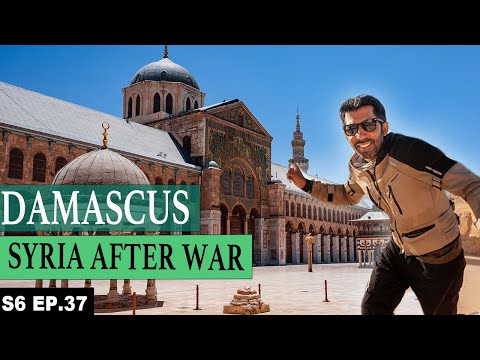DAMASCUS the Impressive Ancient City S06 EP.37 | MIDDLE EAST MOTORCYCLE TOUR

But before the Umayyad Mosque... You'll see the ruins of an ancient Roman temple of Jupiter. Its unique feature is the mosaic and art work on its walls and ceiling. This minaret is dedicated to Jesus Christ (AS). It is believed that Jesus will descend on this minaret on his second coming. This is how the interior of the mosque looks like.
Let me explain it a little for you. Assalam Alekum Everyone and Welcome Back to the Channel from Damascus. It's among the oldest capital cities in the world. It has been continuously inhabited since 3rd century BC till date.
The city has seen the rise and fall of many empires. You can still find the remains of those empires here. I'll try my best to explore this city for you. As a tourist, I can visit many places here. However, some places are off limits for us due to the security situation in Syria.
Anyways, we'll give Syria our best shot. Right now, I'm standing in the old town and that's where we'll start. The old town in Syria is very congested.... And it has small and narrow streets with frequent traffic jams. Let me go into the details... It has 3 - 4 sections.
The area surrounding the Umayyad mosque is mostly inhabited by Sunni Muslims. Right next to it is a small section that is mostly inhabited by Shia Muslims. And then there are Jewish quarter and Christian quarter. Right now I'm standing in the Jewish quarter. This was inhabited by Jews in the past... But most of them have migrated to US and Israel, now.
You can see that some houses are either painted blue or green here. This has been done by the government to mark the true owners of these houses. Most of these houses are abandoned. And they are in bad shape because nobody lives there.
But the color of the paint on the exterior of the house suggests who the owner was. Could be Jews... Could be anyone else... The guide told me that the paint outside the house tells that these are Jewish houses. You'll also notice that the shutters of some shops have the Syrian flag painted on them. This was done to show solidarity during the war.
Because the other groups fighting in the war had their own flags. Right now, I'm standing in a street that is among the oldest streets here. May be the oldest street here. It is even mentioned in the Bible. It's called the Straight Street. Although it's not straight anymore but slightly curved.
Because it has been rebuilt many times in history. If you look down this street... It's a sloped street and it gradually rises a slight slope. The old ruins are towards the lower part. The architecture of houses and shops in this street today date back to 12th - 14th century.
You will also find some signs of the older times. But those are difficult to find. This street goes straight to the Souq; the main covered bazaar of Damascus. Lets go and see the covered bazaar.
Hello, I'm from Syria. Nice to meet you. Nice to meet you. My name is Zain. You'll notice some interesting things while passing through this street. One of them is the woodwork.
They have woodwork factories in small shops. Some do handiwork. You can still find such shops in a main street of the city downtown. Made by hand or on machine... But I have hardly noticed this anywhere else. Let's go inside and see what they are making.
It's a small factory with just a few machines. Let me show you what they are doing here. Some of the items are just in front of me.
Take a look at this.. This looks like a mold to make some sweet or pastry. Other than that... I think it can be used for grinding. What else can we see here...
They have hung most of their items in front of the shop for display. I think this one is used for honey. Don't know about this one. This one is used for cooking. And so is this one.
So this is a small wood work factory of Damascus. This Souq is called Midhat Pasha Souq. If you remember we passed by this souq on our first day. I don't think it's well known by the name of Midhat Pasha... Because everyone calls it... the Spice Market.
As soon as you enter, you are welcomed by a strong smell of spices. And you instantly know that you are in the spice market. Spices are all you'll find in the starting part of this bazaar. Many of these spices have been imported from India. Then there are others which are traditionally used in Arab dishes. You'll also find locally produced spices.
You'll also find coffee. Besides, there are so many clothing shops here like every other country. Since it was made in the Ottoman period... Back in those days, they built inns for caravans for travelers. They would stay at the inn and come to the bazaar for business. I've just spotted a very beautiful gate of one such inn.
It's called 'Khan Caravan Saraye'. That's what was written outside. Next to it are many pathways that lead to the other bazaars. Let's go and see them all. I don't think I have seen any other bazaar in the Middle East, so lively. Such traditionally rich and lively markets are amazing. These have become my favorites.
It is super crowded here. The souq where I'm standing also dates back to the Ottomans and is called Hamidiyah souq. Right in front of this souq is the Umayyad Mosque. But before the Umayyad mosque... You'll see the ruins of the ancient Roman temple of Jupiter. I'm gonna go out from here and try to explain in more detail.
And then we'll head to the Umayyad mosque. You can see the Umayyad mosque on my left side now. And on my right side are the ruins from the Roman period. To share this story, we may have to go way deep into the history. About 1000 years BC when Aramaens used to live here. These are the people whose language is still spoken in some villages in Syria.
Hopefully, we'll pass by their villages in coming days and then I'll share more about them. They built the Hadad temple here for their weather god. Later on, when the Greeks came here they built a temple for Zeus. And when the Romans came here, they built the Jupiter Hadad temple. Romans took almost 4 centuries to accept Christianity as their official religion. After accepting Christianity, the Romans made a big cathedral or church here.
It kept on functioning as a church for 60 years even after the Muslims got here. Afterwards, the Umayyad ruler, Waleed bin Abdul Malik, built the Umayyad mosque here. Whereas, the dome of rock in Jerusalem was built by his father Abdul Malik. Let's get inside and show you the interior of the mosque. I'd also like to share some information about the walls of the mosque to show you how old these are.
This is the outer wall of the mosque. It's made of huge rocks that date back to the Roman times. You'll also notice some restoration work and some other types of stones here.
The part that you are seeing right now was done during the restoration phase. Finally, I'm inside the mosque. It's a bit crowded but I'll still try my best to capture it. This is undoubtedly among the most beautiful mosques that I've ever visited. The very first thing you notice about the mosque is its gate. It has a total of 4 gates; all are identical.
Some work could have been done on these gates by Romans or Umayyads.. Otherwise they are the original gates of this mosque. The unique feature here is the mosaic and art work on the walls and ceiling of the mosque. I don't know the exact word for it in Urdu.
It's very unique and is in really good shape. You'll find similar artwork in the whole mosque. My guide has told me that... Most of this artwork has been inspired by the things promised to us in heavens..
Such as running water streams... and fruits... and greenery... The main difference is that the Greek and Roman artwork was on the floors. But Muslims made it on the ceiling. Moving on...
We are now standing in the huge courtyard of the mosque. We'll make a round of the mosque and share anything interesting that we find with you. This is the main court of the mosque; a rather spacious one. Here, I want to mention two things. Firstly, the minaret that you can see on the left side...
This minaret is dedicated to Jesus Christ (AS) It is believed that Jesus will descend from heaven to this minaret, on his second coming. other than that, there's a minaret on the other side as well, which was built by Mamluks. There are a total of 3 minarets in this mosque; the 3rd one is right at the top of where I'm standing. We can't see it from here.
The structure that you can see in the middle... That's how the mosque would appear from the outside. The artwork on this facade is just too good.
There's a place in the mosque where ... the severed head of Hussain (AS) was brought after he was martyred in Karbala. It was kept here for some days before it was taken back to Karbala. The place is exactly opposite to the point where we entered the mosque. That's the interior of the mosque and you can see how unique it is.
As soon as you enter, you notice two rows of columns. And this is not Muslim architecture. Rather it's Roman as the building was a cathedral when it was constructed.
You can see that above these two rows of columns, there are smaller columns to support the roof. Green color is mostly used in the ceiling. The ceiling is made of wood lined with tin. Besides, you will notice very bright and colorful windows.
This style of windows is not uncommon in Iran, Iraq and Morocco. The columns are now used to divide the mosque in sections. For example the section on the other side of the row is the ladies section. Whereas, the section on this side is for gents. I'm moving about the section in the middle.
There, you can see this dome that was built during the Umayyad period. It was done in order to point towards Makkah. So it's right in the center. Over there, you can see the pulpit where the Imam gives sermons and leads the prayers.
If you continue on this side, you'll see a shrine at the end. This is the shrine of John the Baptist. It is believed that his severed head was brought here from Jerusalem and buried here. The shrine is situated at a far side in the mosque. Right next to the mosque is the final resting place of Saladin.
For the Muslims visiting Damascus, his shrine is a must visit place. That's because the name of Saladin is among the top warriors of the Muslim world. Let me share some brief history before we go to his shrine.
He was a Kurd by birth and ruled over this entire region from 1174 to 1193. There was a battle in 1178. Back then, the Crusaders ruled over Jerusalem. Saladin defeated the Crusaders at Hattin which is a little before Jerusalem. The Crusaders were really strong back then but Saladin was able to conquer Jerusalem. That's why his name is among the top Muslim leaders.
Let's get in and see it from the inside. You can see 3 graves here but actually there are 2. The white one in the middle is that of Saladin. Initially it was covered by a black wooden cover.
But later it was put aside when the shrine was renovated. Buried beside him is a Shaikh who raised his voice against the fanatics in the Syrian war. Later, he was martyred in a bomb blast while he was in the mosque. Coming out of the shrine, you set your eyes on the old minaret of the mosque. At the bottom of the minaret, there are some columns from the ruins of Roman times.
It looks really beautiful. This is the back side of the mosque. Around the mosque are small but colorful bazaars. Each one of them is different from the other. You'll find amazing ancient cafes in there.
I'm sitting in a cafe whose building dates back to the 14th century from Mamluk times. So you can see that it's almost 800 years old. Even this cafe is 100 years old.
An interesting thing about this cafe is that story tellers would come here ... and tell different stories from around the world. Although, times have changed but it's still crowded with people. The place is crammed with locals. A lot of people here smoke Sheesha. So you'll find men and women smoking sheesha here. You'll find people of all ages here.
Not the underage people obviously, I mean. I have ordered coffee and traditional bread for myself. The bread has cheese in it so it's gonna be our lunch for the day. Gonna show you some more places after lunch. We are here to visit Azem Palace which is a palace in the old town. It was built during the Ottoman period in the middle of the 18th century.
It was named after Sultan Asad Pasha Al-Azem. There used to be two palaces right at this location before this one. Those two palaces dated back to Umayyads and Mamluks. But this was built on the ruins of those two palaces by Asad Pasha. Some rooms are opened for tourists.
I visited the rooms and I'm highly impressed by the traditional wooden work. The furniture here is splendid and it is said that it also had ivory along with wood. Must be really expensive furniture for sure. Since, the palace was for the family of Pasha, it had some rooms for winter. While there were other rooms for summer that had fountains.
That was done to create a cool atmosphere for the summer time. That's why there are many trees here as well. I've just come out of the old city.
The old city is on our right side. This wall that you can see is the citadel wall. It's just beside the Hamidiyah souq. And this road in the middle is sort of a border between the new city and the old city. You can see the buildings of the new city in the background.
After a walk of 10 minutes from the old town, I've reached here. The train behind me, may have suggested you that this is the famous Hejaz Railway Station. It was constructed by the Ottomans in 1911 or 1913. And for the first time in history, a train carried pilgrims from Damascus to Medina. The original plan included extending the railways to Makkah but it could not be accomplished.
Starting from 1911 or 1913, this project continued through World War I. However, this project ended with the end of Ottomans. I've seen the railway tracks at many points in Saudi Arabia and Jordan that were uprooted. I just came to know that the Syrian government had this plan to revive this project. A train used to go from here to Dariyah at the Jordanian border. But that was before the war.
Now, there is only one train here that takes the locals to the mountains, only once a week. No train other than that. This station was called Hejaz because the region of Makkah and Medina is called Hejaz. The other region of Riyadh was called Najd. Today, Hejaz and Najd collectively constitute Saudi Arabia. About 15 km from Damascus, is a city by the name of Syeda Zainab.
That's where the shrine of Hazrat Zainab (RA) I've just visited the shrine. It's a rather grand place that receives a large number of pilgrims from all over the world. Even now, it was quite crammed. The architecture inside is very similar to what they have in the other shrines in Iran and Iraq. It's constructed in a similar style.
A lot of renovation work is still in progress here. We have come to the city center of the new city by a short drive. We must have driven for 15 minutes hard.
Throughout, there was hardly any area that had electric power. Due to lack of power, more than half of the city is closed just after sunset. Power shortage has also forced factories to close down and made many people jobless.
It's only 8 pm and only the shops with power generators are open. Everything else is closed. That' what you feel in all areas as soon as the dusk falls.
2022-09-19 02:00


